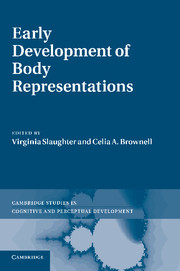Book contents
- Frontmatter
- Contents
- Figures
- Tables
- Contributors
- Part I The bodily self
- Part II The bodies of others
- 5 Developing expertise in human body perception
- 6 Children’s representations of the human figure in their drawings
- 7 Understanding of human motion, form and levels of meaning
- 8 How infants detect information in biological motion
- 9 The integration of body representations and other inferential systems in infancy
- Commentary on Part II Yet another approach to development of body representations
- Part III Bodily correspondences
- Index
- References
7 - Understanding of human motion, form and levels of meaning
evidence from the perception of human point-light displays by infants and people with autism
from Part II - The bodies of others
Published online by Cambridge University Press: 25 October 2011
- Frontmatter
- Contents
- Figures
- Tables
- Contributors
- Part I The bodily self
- Part II The bodies of others
- 5 Developing expertise in human body perception
- 6 Children’s representations of the human figure in their drawings
- 7 Understanding of human motion, form and levels of meaning
- 8 How infants detect information in biological motion
- 9 The integration of body representations and other inferential systems in infancy
- Commentary on Part II Yet another approach to development of body representations
- Part III Bodily correspondences
- Index
- References
Summary
The study of the development of infant responses to the visual representation of the human form in photographs and drawings is clearly important, but equally so is consideration of the role that human motion plays in delivering meanings about the bodies of other people. Much is still to be learned about infants’ abilities to represent the whole human form, and to establish which of the material properties of humans are used and encoded by infants. Moreover, we need to consider the role that specific patterns of motion might play in the formation of these representations. Evidence on these issues has emerged from the study of responses to human point-light displays (PLDs). In this chapter I review evidence on the emergence of abilities to perceive different ‘levels of meaning’ conveyed by human PLDs and then outline how consideration of these levels of meaning can help in understanding potential difficulties that people with autism may have in perceiving and making sense of human bodily motion.
Levels of human bodily motion
Before we proceed we need to clarify the distinction between the terms human motion, biomechanical motion and biological motion. These terms are sometimes used without sufficient consideration. The term biological motion can be considered to cover all forms of motion shown by animals, with the most basic level of motion being that of self-starting irregular, partially contingent motion. Biomechanical motion is a more specific aspect of biological motion that is associated with having articulated moving limbs. This is movement that humans and many, but not all, animals show. While human motion is biological and contains biomechanical movement that overlaps with that of many animals, human motion also has specific properties that are constrained by the human form, with the arms and legs being vertically aligned, and that also convey important conspecific social and psychological meanings. Thus there are levels of subtlety to the patterning of human motion that we may be particularly attuned to. The point is that we should not consider that human motion is simply equivalent to or synonymous with biological or biomechanical motion, and when considering the literature on the development of these abilities we must keep in mind these distinctions.
- Type
- Chapter
- Information
- Early Development of Body Representations , pp. 122 - 145Publisher: Cambridge University PressPrint publication year: 2011
References
- 2
- Cited by

